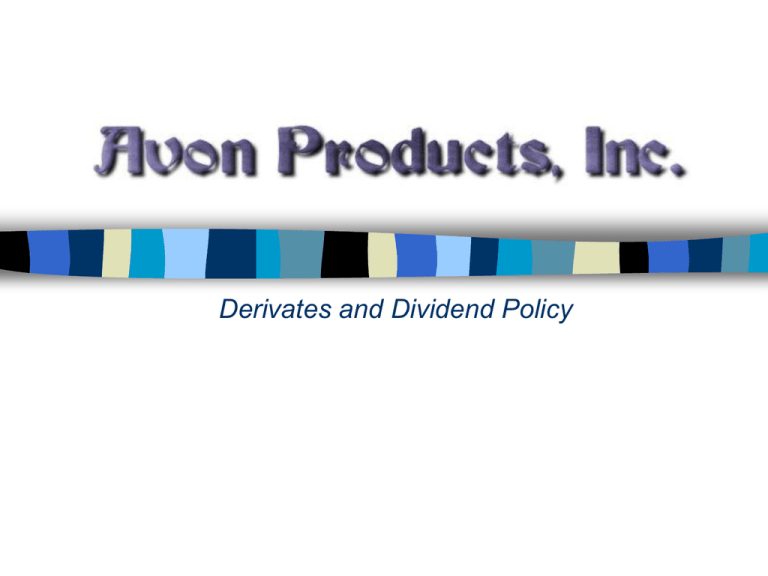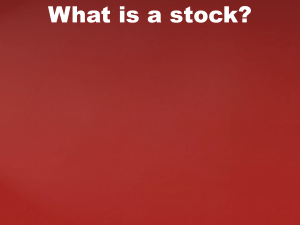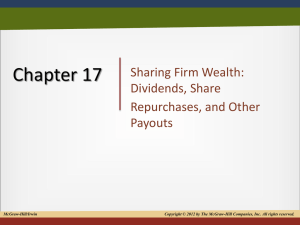Why is Avon reducing its dividend?
advertisement

Derivates and Dividend Policy Introduction In 1988, Chairman and CEO of Avon Products, Hicks B. Waldron, was scheduled to propose three topics to Avon’s board of directors on June 2nd. These three topics included: – The public announcement that Avon would plan to sell off two of it’s businesses that were previously acquired, which would result in an overall book-value loss – A reduction of the common stock dividend – An announcement of an exchange offer that Avon’s financial advisor proposed in which preferred stock for 25% of common shares would be implemented. Avon Products, Inc. Background Soon after it’s establishment in 1886, Avon Products began to rise as one of the largest companies to sell beauty supplies. Sales were split in two different marketing groups. One being distributional, which is producing and selling the supplies to department stores and other retail outlets, and the other being direct selling, or door-to-door sales. The marketing split was heavily weighted on the direct selling side at the time. Employees, working out of their homes and such, spoke to friends, family, and neighbors about Avon’s beauty products. Their selling strategy boosted revenues and made up for most of the early company profits. The other developing industry that Avon had been investing in was Healthcare. Examples of these businesses include Foster Medical Corporation, Mediplex Group, and Retirement Inns of America. These healthcare groups provided new services beyond Avon’s beauty business, which created optimism in future returns. By 1988, Avon had about 400,000 sales reps located in the United States, and about 1.4 million worldwide. Avon Company History In 1981 Avon increased it’s dividend on common stock from $2.55 up to $3.00. More importantly they decided to diversify their business by entering the health care field. – In 1982 they acquired Mallinckrodt, a chemical company specializing in health care. Changing Times A major demographic shift started. Women who normally stayed at home all day now were getting jobs that took them out of the home. This caused a loss in both their sales force and their customers. Changing Times By mid 1982 they had a weakening cash flow because of the declining business and the $170 million Mallinckrodt acquisition. Avon in turn reduced their dividends from $3 to $2/ share. The stock price remained steady after the announcement because it had already dropped from $30 to $20.375 prior to this and investors were expecting the drop in dividend. Company Changes In 1984 the new Avon CEO, Hicks Waldron, began to redesign the company’s beauty operations. Avon no longer focused on direct sales, but rather distribution channels. However, they would look for other acquisitions in case the changes to the beauty business failed. Company Changes There was a possibility the public health care policy could change from hospitalbased care to home-care. When Avon acquired Foster Medical Company in May 1984 things started to look up because they specialized in home-care. Company Changes Avon also acquired Retirement Inns at the end of 1985 and Mediplex mid 1986. – They both managed retirement living centers. – Mediplex also operated sub-acute health care facilities like alcohol and drug abuse centers. Avon sold Mallinckrodt in 1986 for $675 million to focus on provision health care. Avon’s Reorganization Foster Medical’s revenues primarily came from Medicare, the largest public health insurance programs in the US. A change in Medicare in 1986 cut Foster Medical’s charges for patients by 18% – Foster Medical did not respond well to the change. Avon’s Reorganization Avon’s management recommended it review Avon’s commitment to the health care industry. – It was decided that Foster Medical, Mediplex, and Retirement Inns could no longer show acceptable profit. By 1987 Beauty Group began to improve markedly. Beauty Group’s strength allowed Avon to shed the Health Care Group companies. It sold Foster Medical Supply in late 1987. Early 1988 Avon also started selling the entire Foster Medical Corporation. – Avon anticipated and after-tax loss of $125 million on the sale. Avon’s Reorganization In 1987, Avon acquired Giorgio, Inc for $165 million cash and Parfums stern, Inc for $160 million. This added prestige fragrances, sold through retail stores, to Avon’s beauty line. It also continued Avon’s transition away from direct sales approach. The Exchange Offer Mr. Waldron recognized that the massive reorganization of the business should be followed by a reorganization of Avon’s financial policies Sufficient capital would be needed to invest in the company to expand the beauty products business December 1987- Avon sold 40% of the CS of subsidiary The board felt that a reduction of dividends was necessary to conserve cash flows Reduce Dividends from $2.00-$1.00 The Exchange Offer Mr. Waldon was worried about the consequences of simply cutting Avon’s dividend. Even though the last dividend cut didn’t result in a drop in Avon’s stock price, it probably would this time around. The stock price has remained steady, and the 1987 annual report stated that Avon expected to “maintain the current dividend of 2$” A sudden cut of the dividend would be disastrous for Avon, as most of the major shareholders would sell their shares. “For five years I had been telling them that we weren’t going to cut the dividend, and for five years they had been telling me they didn’t believe me” – Hicks B. Waldron 25 Largest Institutional Holders of Avon Stock The Exchange Offer A similar security was successfully marketed by Americus Trust called PRIME units. Mr. Waldron knew Avon needed to offer an alternative to simply cutting the dividend in order to make their stock attractive. Americus Trusts’ sole asset was common stock of a particular company The board looked toward their financial advisor, Morgan Stanley, to find a solution to the problem. Shareholders of the company would place their shares in a trust and are issued 2 units: a PRIME and a SCORE, against each share At a predetermined date, trust would liquidate all shares PRIME holders would receive value of shares up to a predetermined level SCORE holders would receive any excess Some investors had stated that they held Avon stock ONLY because it paid a high dividend. Morgan Stanley’s answer was a relatively new type of Preferred Stock: PERCS (Preferred equity-redemption cumulative stock) Characteristics of the PERCs Shares Avon would offer to exchange one share of a new $2.00 PERCS for each of up to 18 million of Avon’s 7.17 million outstanding common shares. New preferred would pay cumulative quarterly dividends of 50 cents The company would be able to redeem the preferred shares at any time according to a declining schedule – Redemption price would be $34.75/share plus accrued dividends, for the quarter starting June 1, 1988. It would decline by 25 cents per share for EACH QUARTER thereafter. Avon has option of redeeming the preferred for either cash or common shares Mandatory redemtion of the PERCS shares on September 1,1991. Avon Case Questions 1 + 2. Why was Avon restructuring its business? Did the changes make sense? Why is Avon reducing its dividend? Avon Products, Inc. restructured its business to comply with ongoing changing market conditions. The changes made sense and were necessary. Due to the overwhelming demographic shift away from stay at home mothers, a new business model was needed. As a result of the shift, Avon’s margins on beauty product sales declined from 1979 to 1981. In 1984, Avon’s new CEO, Hicks B. Waldron devised a plan to build on the beauty business through distribution channels more than direct sales. By 1987, distributional beauty sales began to pick up. This lead to the transformation away from the direct sales approach, as Mr. Waldron intended. Under the safety of the new beauty business revenues, Mr. Waldron then decided to sell off the healthcare companies that were previously acquired, including Foster Medical Corporation. These decisions to adapt Avon Products, Inc. with the continuously fluctuating economy created a safety net. The company then felt threatened. Avon started to develop additional distribution channels and purchasing healthcare companies in an attempt to diversify assets and prevent loss. After acquisitions, cash flow was very weak, and Avon felt the need to cut dividends for shareholders from $3.00 to $2.00 per share per year. The dividend cut was needed in order to provide more cash to reinvest in their new channels of business. Avon Case Questions 3. What was the purpose of the exchange offer? The purpose of the exchange offer was to create a safety measure to prevent investors from selling their shares as a result of the reduction in dividends and the subsequent drop of the stock price. Investors had stated that they held Avon stock because of the high dividend that was paid to them. In a previous attempt at conserving cash flow in 1982, Avon reduced it’s dividend from $3.00 to $2.00 per share per year. At that time the stock price had been steadily decreasing and investors had expected the cut in dividend price. This expectation cut the potential negative affect upon the stock price. Avon’s Board of Directors were worried that a further decrease in dividend would result in investors selling their shares because the dividend reduction would drive down stock prices. CEO Mr. Waldron had stated that for five years, shareholders were convinced the dividend would be reduced further from $2.00 to $1.00. Even though Mr. Waldron had told them it wouldn’t, the cash situation worsened. Avon wanted to provide incentive for the shareholders to hold the stock, so the board of directors then asked their financial advisor, Morgan Stanley, about the situation. PERCS (preferred equity-redemption cumulative stock) were then introduced. The overall purpose of the exchange to $2.00 PERCS was to provide shareholder comfort, stability, and trust, which in turn creates long-term shareholder loyalty. Evaluation of Options 4. How would you evaluate the trade-off between accepting the new preferred and keeping the CS? PERCS Shares Better for an investor who requires high dividends Senior standing to common stock Includes a restriction providing that Avon could never pay a common dividend of $1.50 or more per share per year unless it first redeemed the preferred No voting rights Fixed dividend On expiration date, the holders would receive one common share for every PERCS share if the price of the common stock was less than or equal to $31.50, or $31.50 worth of CS per PERCS share, or the cash equivalent, if the CS was above that price. Gives up the call option by taking PERCS Common Stock CAN NOT be redeemed at any time unlike the PERCS, which can be redeemed according the decline schedule More control- will not loose shares if price jumps above $31.50 Lower dividend Voting power What is a fair price for the PERCs? 5. What is a fair price for the PERCs security? PERCS = Stock + PV of Excess Dividends – Call Price with Strike of $31.50 PV of Excess Dividends = PV of the Dividends in excess of $1.25 Call Price = Value of the call option that the preferred holders forfeit Call Price was found using an Options calculator: – – – – – – K = 31. 50 S= 24.125 T= 3 Years Volatility = 31.3% Rf= T-Bill Rate= 8.2% Call Price = $4.914 PV of Excess Dividends = .1875/(1.082)^3/12 + .1875/(1.082)^.5 + .1875/(1.082)^9/12 + .1875/(1.082)^1 + .1875/(1.082)^15/12 ……… through all dividends accrued until Sept 1991 – PV of Excess Dividends = 2.129 PERCs = 24.125 + 2.129 – 4.914 = $21.34 Therefore, a fair price for the PERCs shares would be $21.34 Summary of the Decision The decision as to whether or not to take the PERCs shares or keep the common stock depends on the expectation of future stock prices. Since the shares can be redeemed for cash according to a declining schedule, if the investor expects the price to rise above $31.50, it would be wise to keep the CS shares ever with the lower dividend payments. If the investor expects the price of the shares to stay below the redemption prices, take the PERCs shares in order to reap the benefits of a higher dividend payment for the three years until mandatory redemption After three years, PERCs will be redeemed for common stock shares. The holders would receive one common share for every PERCs share if the price of the common stock was less than or equal to $31.50 If the stock prics is above $31.50, the holder would receive $31.50 worth of CS for each PERCs share.







